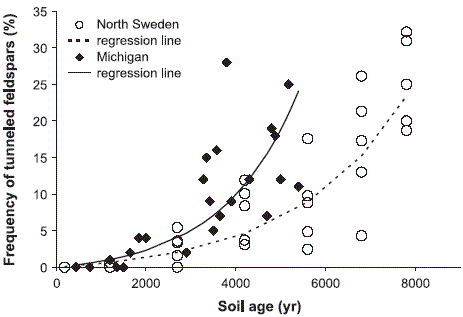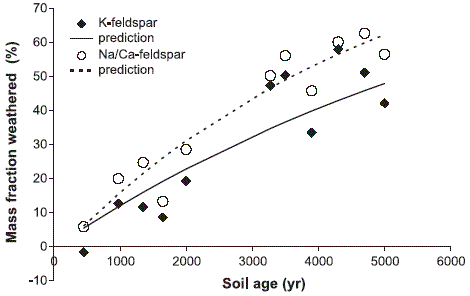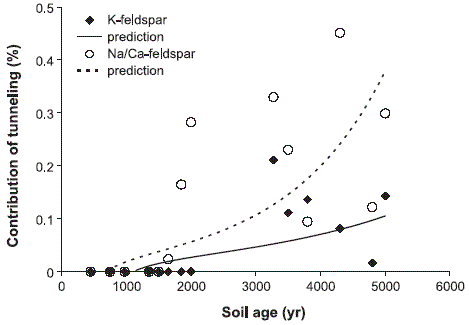 Fig. 2. Percentage of feldspar grains with tunnels in the uppermost 2 cm of the E horizon of the Naubinway and the North Sweden podzol chronosequences (Hoffland et al. 2002). The lines represent fits, based on log-linear regression: (a) North Sweden ( Y=10(1.77851E-4X)-1, R2=0.85); (b) North Michigan ( Y=10(2.59255E4-X)-1, R2=0.76). The lines differ significantly ( p <0.0001). 図2.NaubinwayのE層の最上部2cm部分と北スウェーデンのポドゾル・クロノシーケンス(Hoffland et al. 2002)における穿孔をもつ長石粒子の百分率。2本の線は、対数-直線回帰にもとづく適合を表わす:(a)北スウェーデン(Y=10(1.77851E-4X)-1, R2=0.85);(b)北ミシガン(Y=10(2.59255E4-X)-1, R2=0.76)。2本の線は有意に異なる(p <0.0001)。  Fig. 5. Weathering of feldspars with time as illustrated by the feldspar content, given as a percentage of the mass of feldspars originally present in the parent material. The lines represent fits, based on log-linear regression of the E material, see Fig. 4. 図5.母材にもともと存在していた長石の質量%として与えられ、長石成分ごとに示された、時間に対する長石の風化。2本の線はE物質の対数-直線回帰にもとづく適合を示す、図4参照。  Fig. 7. Contribution of fungal tunneling to feldspar weathering, expressed as the ratio between tunnel volume and weathered feldspar volume. The curves are calculated using Eq. (1), with tunnel volume and weathered feldspar volume based on the regression lines in Figs. 3 and 5: (a) Kfeldspar (R2=0.30; p =0.18); (b) Na/Ca-feldspar (R2=0.48; p =0.08). 図7.穿孔体積と風化長石体積の比として表わされた、長石風化に対する菌類による穿孔の寄与。2本の線は、図3と5の回帰線にもとづく穿孔体積と風化長石体積を用い、式(1)を使って計算されている:(a)カリ長石(R2=0.30; p =0.18);(b)Na/Ca長石(R2=0.48; p =0.08)。 〔『Smits,M.M., Hoffland,E., Jogmans,A.G. and van Breemen,N.(2005): Contribution of mineral tunneling to total feldspar weathering. Geoderma, 125, 59-69.』から〕 |
①境界面は滑らかである。
②直径は2~10μmで、一定である。
③トンネルの終端は丸い。
K長石のトンネルは径5.6μm程度で、風化期間は3275年以上で出現。